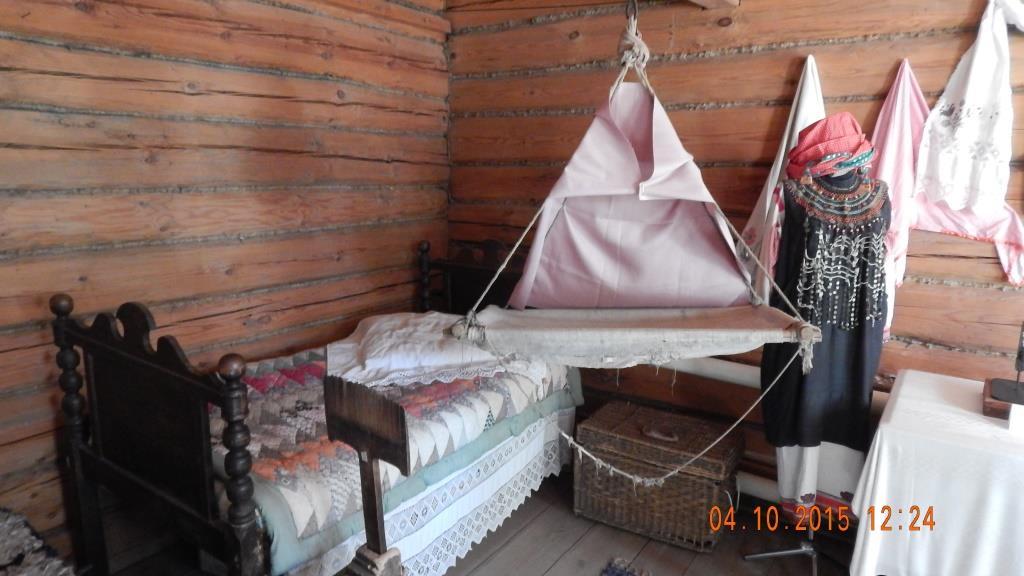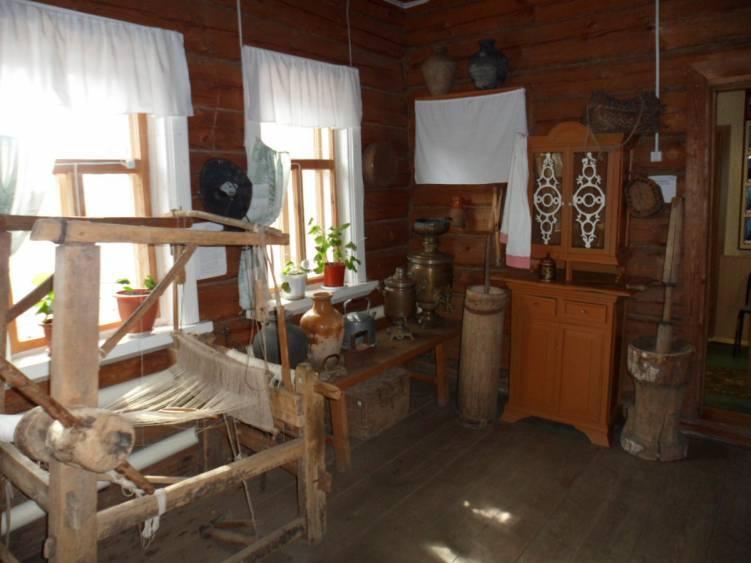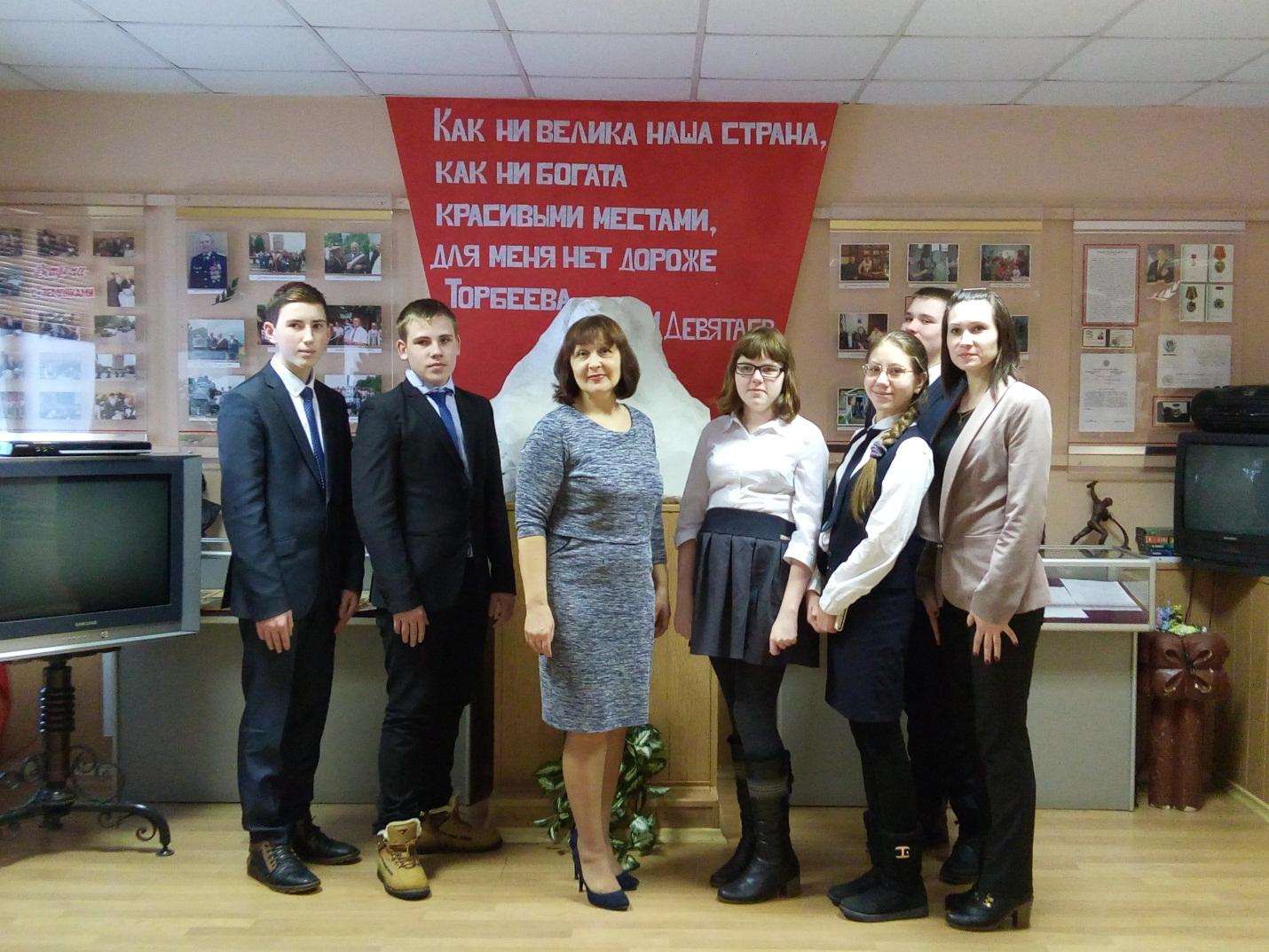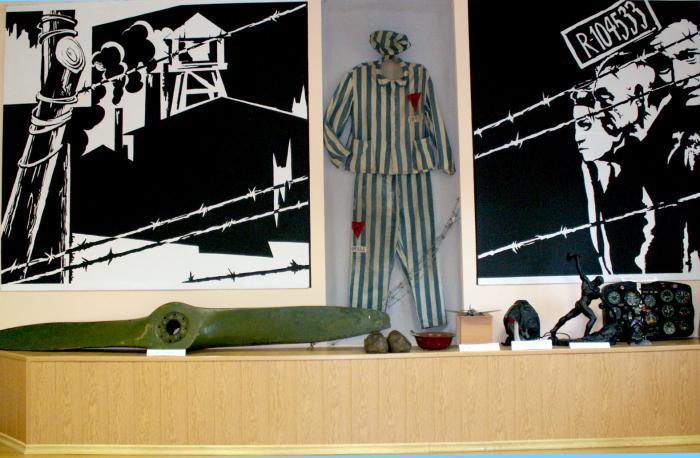
МБОУ «Торбеевская средняя общеобразовательная школа № 1»
Итоговое задание по курсу
«Реализация требований ФГОС ОО
в иноязычном образовании» № 2
«Живой урок» английского языка
по теме «Famous people. Legendary person»
Интерактивная экскурсия
«Посещение музея имени М.П.Девятаева»
Выполнила: учитель английского языка
Пронькина Л.Ю.
2017 год
1.Методическая разработка урока английского языка « Живой урок »
2.Класс: 8 Б
Дата: 05.04. 2017
3.Тема: «Famous people. Legendary person»
4. Маршрут: школа – музей имени М.П.Девятаева – школа
5.Цели урока:
- создать условия для формирования ценностных отношений к Родине, её историческому прошлому, повышения познавательной и творческой активности обучающихся;
- познакомить учащихся с экспозицией музея.
6.Задачи урока:
Практические:
Образовательные:
расширение лингвострановедческого кругозора обучающихся;
активизация лексики по теме «Известные люди. Герои минувшей войны»;
совершенствование навыков письма, чтения, говорения и аудирования по конкретной теме.
Развивающие:
развивать языковую, коммуникативную и социокультурную компетенции;
развивать память, мышление, внимание при изучении материала по теме;
развивать творческие способности обучающихся;
развивать навыки самостоятельной работы учащихся при подготовке сообщений на английском языке;
развивать умение осмысленно отвечать на поставленные вопросы.
Воспитательные:
формирование чувства патриотизма к истории страны и любви к ее народу средствами английского языка;
воспитывать умение работать в группах, в парах и в коллективе.
7. Планируемые результаты:
Предметные:
формирование произносительных навыков;
введение. отработка и употребление новой лексики по теме: « Известные люди»;
формирование грамматических навыков по теме «Прошедшее время»
Личностные:
формирование коммуникативной компетенции в межкультурной и межэтнической коммуникации;
формирование общекультурной и этнической идентичности как составляющих гражданской идентичности личности;
стремление к лучшему осознанию культуры своего народа и готовность содействовать ознакомлению с ней представителей других стран; толерантное отношение к проявлениям иной культуры.
Метапредметные :
умение извлекать информацию на разных уровнях в соответствии с поставленной коммуникативной задачей,
умение проанализировать полученные данные и интерпретировать их,
развитие умения планировать свое речевое и неречевое поведение, владение языковыми средствами, излагать свою точку зрения, используя языковые средства.
Межпредметные связи:
8. Формат: интерактивная экскурсия « Посещение музея имени М.П. Девятаева»
9. Продолжительность: 2 урока (90 мин).
10. Урок проходит в музее имени М.П. Девятаева.
Ход урока:
1.Организационный момент. Приветствие:
Teacher:
Good morning, dear children! I am glad to see you! How are you?
What date is it today? What day of the week is it today? What is the weather today?
What season is it now?
What means the motto “Never give up!”? Translate please into Russian. (Обучающиеся переводят)
Today we have an unusual lesson. It’s an excursion. We are going to have a talk about famous people of our country and to visit Devyataev’s museum.
2. Фонетическая разминка
Let’s practice the pronunciation. Repeat the words:
3. Речевая разминка
Do you know any famous people in our country? What are they famous for?
4. Проверка домашнего задания (опрос лексики)
Famous people
- to be born - родиться - to be (быть) a famous scientist
- to die - умереть - to become(стать) an outstanding singer,
musician
- to study at, to do at – учиться в a popular writer
- to marry - жениться a wellknown sportsman
- to divorce - развестись actress, actor
- to be interested in - интересоваться dancer
politician
hero
Повторение темы «Past Simple/Perfect/Continuous»
Обучающиеся рассказывают об образовании видо-временных форм глагола и приводят примеры.
5. Совершенствование навыков диалогической и монологической речи.
Do you know any famous people in our republic? What are they famous for?
Have you ever been to the Museum of Devyataev? Who is it? What is he famous for?
Обучающиеся отвечают на вопросы.
Of course, every country is famous for its people.
Let’s listen some information about legendary person of our country.
Обучающиеся в качестве гидов рассказывают заранее подготовленную информацию
о М.П.Девятаеве, остальные осматривают экспозицию.
1 Pupil:
Mikhail Petrovich Devyatayev (Russian: Михаил Петрович Девятаев; Moksha/Erzya: Михаил Петрович Девятаев; 8 July 1917 – 24 November 2002) was a Soviet fighter pilot known for his incredible escape from a Nazi concentration camp on the island of Usedom, in the Baltic Sea.
Early life and military career
Born in 1917 at Torbeyevo, Mikhail was the thirteenth child born to the family of a Mordovian peasant. In 1938 he graduated from a School of River Navigation (Речной Техникум) and worked as the captain of a small ship on the Volga. That same year he was conscripted into the Red Army and began education at a Chkalov Flying School, graduating in 1940.
Devyataev was an early entrant of World War II, destroying his first Ju-87 on 24 June 1941 just two days after Germany attacked the Soviet Union. Soon he was awarded the Order of the Red Banner. On 23 September he was seriously wounded (he was hit into his left leg). After a long stay in the hospital he was assigned to slow-speed aviation (Night bomber Po-2) and then to medical aviation. He resumed his duties as a fighter pilot after his meeting with the famous Soviet ace Aleksandr Ivanovich Pokryshkin in May 1944. Commander of an echelon with the 104th Guardian Fighter Pilot Regiment (9th Guardian Fighter Pilot Division, 2nd Airforce Army, 1st Ukrainian Front), Senior Lieutenant Devyatayev destroyed 9 enemy planes.
2 P:
Capture and imprisonment
On 13 July 1944 Devyataev was downed near Lwów over German-held territory and became a prisoner of war, held in the Łódź concentration camp. He made an attempt to escape on 13 August but was caught and transferred to the Sachsenhausen concentration camp. He soon realised his situation was perilous-as a Soviet pilot, he could expect extreme brutality; therefore, he managed to exchange identities with a dead Soviet infantryman.
With his new identity, Devyataev was later transferred to a camp in Usedom to be a part of a forced labor crew working for the German missile program on the island of Peenemünde. Under hellish conditions, the prisoners were forced to repair runways and clear unexploded bombs by hand. Security was rigidly enforced with vicious guards and dogs, and there was little chance of escape. Even so, by February 1945, Devyataev concluded that, however remote, the chance of escape was preferable to certain death as a prisoner.
3 P:
Escape
Devyataev managed to convince three other prisoners (Sokolov, Krivonogov and Nemchenko) that he could fly them to freedom. They decided to run away in the dinnertime, when most of the guards were in the dining room. Sokolov and Nemchenko were able to create a work gang from Soviet citizens only, as they didn't know foreign languages to communicate freely and coordinate their plans with other inmates.
At noon on 8 February 1945, as the ten Soviet POWs, including Devyataev, were at work on the runway, one of the work gang, Ivan Krivonogov, picked up a crowbar and killed their guard. Another prisoner, Peter Kutergin, quickly stripped off the guard's uniform and slipped it on. The work gang, led by the "guard", managed to unobtrusively take over the camp commandant's He 111 H22 bomber and fly from the island. Devyataev piloted the aircraft.
The Germans tried to intercept the bomber unsuccessfully. The aircraft was damaged by Soviet air defences but managed to land in Soviet-held territory. The escapees provided important information about the German missile program, especially about the V-1 and V-2.
After a short time in hospital, in late March 1945 seven of the escapees were sent to serve in the rifle unit, five of them died in action over the following weeks. The three officers were suspended for a longer investigation till the end of the war.
4 P:
Postwar
Devyataev was discharged from the army in November 1945. However, his classification remained that of a "criminal" and so he was unable to find a job for a long while. Eventually, though, Devyataev found work as a manual laborer in Kazan. Soviet authorities cleared Devyataev only in 1957, after the head of the Soviet space program Sergey Korolyov personally presented his case, arguing that the information provided by Devyataev and the other escapees had been critical for the Soviet space program. On 15 August 1957, Devyataev became a Hero of the Soviet Union, and a subject of multiple books and newspaper articles. He continued to live in Kazan, working as a captain of first hydrofoil passenger ships on the Volga. In 1972, he published his memoirs “Flight to the Sun” and in 1988 “Escape from Hell”. It is the world famous book of Devyataev.
5 P:
Awards
Devyataev was awarded the Order of Lenin, the Order of Red Banner twice, Order of the Patriotic War (first and second class), and many other awards. He became an honoured citizen of Mordovia Republic, the cities of Kazan, Wolgast and Zinnowitz (Germany).
Death and legacy
He died at Kazan in 2002, aged 85, and is buried in an old Arsk Field cemetery in Kazan near a World War II Memorial. There is a museum of Devyataev in his native Torbeyevo (opened 8 May 1975) and monuments in Usedom and Kazan.
He was really the greatest hero, the legendary person not just for our republic, for our country but for the while world.
6. Викторина
What do you know about Devyataev?
1. When and where was Devyataev born?
2. When did he begin education at a Chkalov Flying School?
3. Tell the concentration camps where was Devyataev?
4. When did he do his famous escape?
5. Why was he unable to find a job for a long while?
6. What kind of awards had Mikhail Petrovich got?
7. When and where did Devyataev die?
7.Домашнее задание
Подготовить презентацию о выдающемся человеке Мордовии.
8. Подведение итогов.
I think the lesson was very useful for you, it was interesting. Now you can tell the English speaking tourists about our hero M.P.Devyataev.
9.Рефлексия
What was new for you?
What was easy for you?
Maybe, anything was difficult for you?
Fill in the table:
Прием «Необитаемый остров»
| It was difficult for me … | To understand new words To read new words To make grammar exercises To translate the text To make the dialog Etc. |
| Help me, please … | To learn verb tenses To learn how to make the dialogs To learn how to spell English words To learn how to make degrees of comparison of adjectives To learn how to make plural nouns To learn how to make mind-map Etc. |
| From:
| To: |
I like your work.
Our lesson is over.
Good bye.
10. Список источников
https://en.wikipedia.org
https://kopilkaurokov.ru
http://www.mrkm.ru/
УМК «Английский в фокусе» Д. Дули, Е.Ю.Ваулина учебник для 8 класса



Наши гиды

































